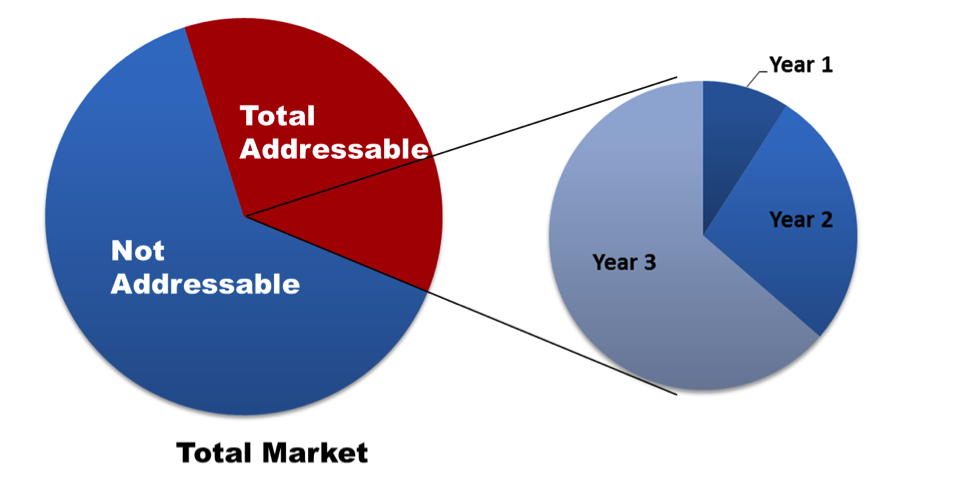Welcome to Module 4 of the Online Market Validation Training program. Brief intros, plus module and video links can be found below.
Multimedia links:
- Total Addressable Market (TAM)
- Sales & Prospects
- Competitive Landscape
- Ideal Customer Characteristics
- Product Roadmap and Minimum Viable Product (MVP)
4.1 Total Addressable Market
Market sizing is about quantifying the viability of your idea as a business. How many customers can you sell to in your segment? What kind of revenues can you forecast in year one, two and three? Does this represent a healthy business to pursue, or do you need to pivot?
Market sizing may involve a fair amount of research to gather data needed to identify the total market. Market sizing also requires you to “get out of the building” and talk to customers. The Target Market is where you’ll start quantifying your findings—it should align with your segmentation chart.
You’ll need to have completed all your “customer” components first: Buyer Types, Personas, and Ideal Customer Characteristics. These are analyzed as part of the market sizing process.
The market sizing framework results in an overview of the realistic potential of a business opportunity. The size of the market is estimated to ensure that there are enough customers to make the business a worthwhile venture. It’s an estimate of the people who typically need the category of the product or service you are launching.

By calculating the revenue of
- all customers buying at the target price,
- realistic or addressable market buying at likely price, and
- expected market results for the first three years,
you can estimate if the opportunity is, in fact, worthwhile.
Access Multimedia: Total Addressable Market
Video links
4.2 Sales & Prospects
Sales Funnel
 The Sales Funnel is about understanding the sales forecasts for your business, built around a filtering methodology. How many leads do you need to generate in order to meet your sales targets? What is the conversion rate? It also encompasses sales strategy and tactics.
The Sales Funnel is about understanding the sales forecasts for your business, built around a filtering methodology. How many leads do you need to generate in order to meet your sales targets? What is the conversion rate? It also encompasses sales strategy and tactics.
This topic also covers content marketing and how the buying process meets the sales process.
You’ll need to have completed these parts of your market components: Value Chain, Segmentation and Market Sizing. These are analyzed as part of the market sizing process.
Your sales funnel will help you build a practical plan for how to attract and retain customers—a critical part of growing your business
Access Multimedia: Sales & Prospects
4.3 Competitive Landscape
Mapping your competitive landscape is an important part of validating your market and refining your positioning statement. Knowing your competitiors is also helpful when looking at adjacent markets, and helps you confirm your bowling pin strategy.

The competitive landscape brings together your understanding of the market. It gives you tools to understand
- how you compare to the market, and
- what elements about your business will allow you succeed in the market.
You’ll need to have completed: Discovering Your Customer, Market Type and Positioning Statement to ensure that you have the most information as you can towards your Market Positioning.
Access Multimedia: Competitive Landscape
4.4 Ideal Customer Characteristics
Ideal Customer Characteristics is about identifying the key characteristics that your customers exhibit. This is critical for positioning, and helps you determine your segmentation strategy. Whereas the buyer persona identifies what the buyer needs, Ideal Customer Characteristics define what makes that customer a good fit for your business.

Ideal Customer Characteristics is an integral part of understanding the buyer for the product. It’s important to understand these characteristics to accurately understand your customer segments.
Ideal Customer Characteristics analyzes the demographic, sociographic and psychographic drivers of a customer’s need.
4.5 Product Roadmap + MVP
Product Roadmap and Minimum Viable Product (MVP)
Minimum Viable Product needs to be delivered after Positioning Statement, Buyer Personas, Value Proposition, and Segmentation topics. It also needs to follow Customer Development and the TALC topics.
Identifying Minimum Viable Product is really testing market demand for your product. It’s critical that you understand and identify this, as it will impact how you design your business model and/or position your product and how you see your own company/product fitting into the market. The key point is that it is testing product-market fit.

Applying the Minimum Viable Product method introduces discipline into product development. It’s an opportunity to take stock of what customers really want out of a product, not what you think is a killer feature or a must-have feature set. The MVP represents a “reality check” to keep your features relevant.
Building your MVP and your Product Roadmap involves the following activities:
- Validate every product feature
- Match each feature to a customer value—is it worth something to that market segment?
- A pivot vs. a strategic change—a pivot is a change in strategy not a change in vision
- Product changes are not the same as pivots
Access Multimedia: Product Roadmap and Minimum Viable Product
Video Links
- 6. Purpose of a Minimal Viable Product
- 7. MVP vs. Waterfall Development
- 9. MVP for Web/Mobile Product
- 10. MVP for a Physical Product
- 12. MVP + Value Proposition
- 14. The Art of MVP
- 16. Business Model Canvas + MVP
